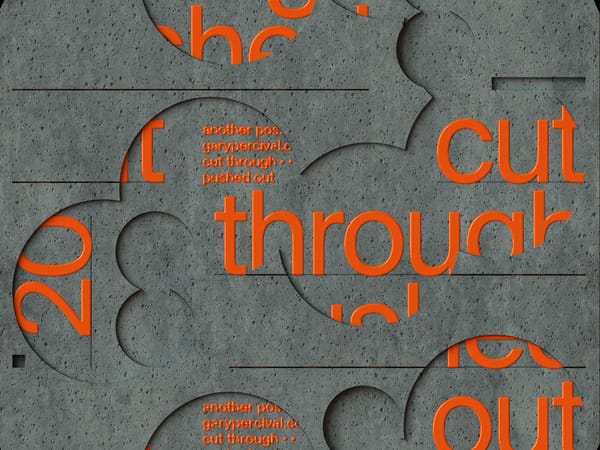Breaking the Echo Chamber: Why Creativity Demands More Than One Influence
“Creativity isn’t about following a single roadmap—it’s about exploring the terrain.”
Have you ever noticed that your creative influences all come from the same place? It’s easy to fall into an echo chamber—where one idea, method, or teacher shapes everything you do.
Algorithms reinforce what we already believe. We follow the same voices, swear by the same mentors, and before we know it, our creative world becomes a closed loop. But creativity needs contrast, contradiction, and variety to truly thrive.
Let’s explore why relying on just one perspective might be holding you back—and how breaking out of the echo chamber can make your work stronger.
The Illusion of the One True Way
Many creatives start out by following a single voice.
Maybe it's a designer whose work you admire, a well-known freelancer sharing business advice, or a course that changed how you think about your craft. These are important stepping stones, but they can also become intellectual traps.
Here's how it happens:
- The Method Becomes the Law—You learn a workflow, pricing strategy, or design philosophy and start to believe it's the only valid way.
- You Stop Questioning—Instead of experimenting with new techniques, you default to what you were taught, assuming it's always the best approach.
- You Reject Alternative Views—When exposed to different perspectives, you dismiss them because they contradict what you already "know."
- Your Work Becomes Predictable—Instead of evolving, your style or approach starts to feel formulaic, missing the creative spark that comes from exploration.
This is how the echo chamber forms—not because the original teacher or method was flawed, but because it was never meant to be your only input.
The Risk of Stretched-Too-Far Ideas
Even the best creative principles have limits.
A design trend that works beautifully in branding might not translate well into editorial design. A pricing model that succeeds for one freelancer might fail for another.
Take minimalism, for example. A designer inspired by Dieter Rams or Japanese aesthetics might see simplicity as the ultimate goal. But when minimalism is applied without considering the client's brand personality, audience needs, or communication goals, it can become an obstacle rather than an asset.
The same applies to business advice. Some designers swear by value-based pricing, while others thrive with tiered packages or day rates. If you follow one pricing strategy blindly, you might miss an approach that works better for your niche, skills, or audience.
Expanding Your Creative Influence
So how do you break out of the echo chamber and expand your creative thinking?
Learn from Opposing Voices
Seek out designers, freelancers, and thought leaders who have a different approach than the one you've been following. Read books, listen to podcasts, and watch talks from people who challenge your assumptions. The goal isn't to abandon what works for you but to stay open to alternative methods.
Cross-Pollinate Disciplines
Graphic designers can learn from architects. Illustrators can take inspiration from filmmakers. Motion designers can borrow storytelling techniques from novelists. The most innovative work often comes from merging influences outside your industry.
Experiment Without Attachment
Instead of clinging to one method, treat it as a starting point. Try new techniques, test different pricing models, and explore creative approaches without fearing failure. Even if an experiment doesn't work, it adds to your knowledge.
Engage in Thoughtful Debate
Surround yourself with creatives who don't always agree with you. Honest discussions—where differing perspectives are explored rather than dismissed—are a powerful way to refine your thinking and approach.
Curate Your Learning, Don't Just Consume It
It's easy to binge-watch tutorials and follow industry trends without questioning them. Instead, take a more intentional approach.
When encountering new creative advice or methods, develop a practice of critical evaluation. Consider whether the advice truly applies to your specific work and goals.
Challenge yourself to imagine alternative ways to achieve the same outcome. Sometimes, the most revealing exercise is to ask yourself what would happen if you did the exact opposite of what's being suggested.
This kind of intentional questioning helps you move beyond passive consumption to active learning.
Your Unique Path is Built from Many Teachers
No single method or philosophy holds all the answers.
The best creatives are perpetual students, not disciples of one approach. They absorb influences from many places, filter what resonates, and shape their own unique way of working.
So, beware of the echo chamber. Stay curious. Challenge ideas, even the ones that once inspired you. And most importantly, never stop learning from multiple sources—you never know where the next great insight will come from.
Relying on a single source of inspiration or instruction can limit your creative growth. The best ideas emerge from contrast, debate, and diverse influences. Challenge familiar methods, explore opposing views, and stay open to unexpected insights—your creativity will be stronger for it.
One Perspective Opens Doors, Many Build a Path
One voice can spark an idea, but creativity flourishes when you challenge, combine, and reinterpret ideas from multiple influences. The best creative voices aren’t defined by following one approach—they emerge by questioning, adapting, and experimenting with many.
So, what’s one creative influence outside your usual sphere that you can explore this week?
Until next time,
—Gary



